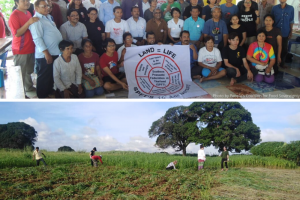This article was first published in a February 2022 issue of OXI, a German economic-political newspaper. The following text in English, retaining the analysis from February, remains relevant in light of the systemic debt problem in many countries in the global South.
The debt problem, especially afflicting the global South, did not happen overnight.
The 2020 economic slump, described by the International Monetary Fund (IMF) as a recession “we have not seen in our lifetimes,” wiped out jobs and worsened inequalities. Many countries in the global South were left with meagre resources to address the pandemic, after decades of financial integration that tied them to volatile whims of foreign capital. The debt problem, lingering before the pandemic, only deepened. Countries were left with limited choices, driving them to more loans.
While 2020 or 2021 did not yet see a full-blown debt crisis, current conditions show that countries are still on the same path. Even according to conservative IMF estimates, global public debt – or the debts incurred by governments – rose by 20 percent in 2020, unprecedented in the last 50 years. In its own estimates by February 2020, and also June 2021, IMF stated that 36 of 70, or half of low-income countries are either at high risk of, or already in, debt distress. At the same time, 70 low-income and middle-income countries have an annual health financing gap of about USD 370 billion, according to the World Health Organization.
Developing countries’ total debt stocks reached USD 11.3 trillion in 2020, according to the UN Conference on Trade and Development (UNCTAD), or two and a half times the post-2009 crisis figures. Developing countries will have to pay around USD 936 billion in debt servicing until 2030 (USD 571 billion in principal and USD 365 billion interest payment), especially on government bonds.
Before the pandemic, countries such as Lebanon, Pakistan, and Argentina have already been experiencing debt problems. Since the pandemic, Chad, Zambia, Ecuador struggled paying their creditors and has sought debt relief under current frameworks.
For many developing countries, revenues from exports are a way of accumulating foreign reserves, such as dollars, to pay debts. In late 2019, fifty-one developing countries under some risk of debt distress are also commodity-dependent, or tied to the export of a few kinds of primary goods (agricultural, mineral, and energy products). Since 2018, and especially in 2020, developing countries’ debt stocks are growing faster than their export earnings.
In 2020, world prices of raw material commodities and overall trade both declined. Countries in the global South earned fewer dollars for their exports. While commodity prices rebounded by the second quarter of 2020, it also contributed to food insecurity in importing countries.
Do current debt responses allow us to travel another path?
Currently, the major international responses to the debt problem are comprised largely of the G20’s debt service suspension initiative (DSSI) and the G20’s Common Framework for Debt Treatments beyond the DSSI. These measures are far from a situation of cancellations from all creditors, longer-term debt cancellations, and most importantly, from ending unequal relations with creditor states and capital-holders.
The DSSI, as its name suggests, only provides for a pause or postponement of principal and interest payments. It was applicable for 73 countries’ debts to the G20 states, which lasted until end-2021. Only 46 of the 73 eligible global South countries actually participated in the DSSI, with the UNCTAD citing fear of “upsetting” their private creditors.
Commentators argue that the USD 5.7 billion that countries “saved” in 2020 will bite back when the repayment of the suspended amounts have to be paid after DSSI concluded. Added to this would be the new debts incurred in the pandemic years from emergency lending, such as through the IMF and the World Bank.
The Philippines, for example, has since become the top borrower from the World Bank after borrowing USD 3.07 billion for fiscal year 2020, an amount that is more than half of what all countries saved from the DSSI initiative. The IMF, known for its legacy of pushing for countries to service their debts and rely on foreign capital, traditionally does not offer grants, only loans.
IMF lending continued into the pandemic, with a total of USD 167 billion in new credit to countries. Moreover, private creditors were still paid by countries USD 14.9 billion in 2020; they have refused even to suspend payments.
Of the USD 35 billion worth of debt suspensions announced by the G20, only a quarter saw the light of day. Or even to the smaller USD 850 million of debt payments under the IMF’s limited cancellation initiative, the Catastrophe Containment and Relief Trust (CCRT). Civil society organisations (CSOs) even point out that the CCRT money also funneled back to the IMF.
Aside from the DSSI, the world has the G20 Common Framework. It is a G20 agreement with the Paris Club, the bloc of lender countries which are also almost all G20 members, as well as China. The agreement hopes to coordinate the G20 and the Club on “debt treatment,” which mostly involved restructuring or adjusting the terms of the debts, such as payment schedules with lenders.
As it is, the Common Framework does not escape, and is actually beholden to the power of the Paris Club. It usually called for countries to face their more powerful lenders and “negotiate” new terms. Chad, Zambia, and Ethiopia negotiated new debt terms with their lenders, and implemented IMF-supported economic policies, as conditions to receive more IMF loans.
Overall, debt suspensions meant a postponement of payments, and restructuring meant setting new terms to paying the debts. Both do not free debtor countries from the large stocks of debt. Countries remain on the same path: duty-bound to pay their lenders. These responses, in the long run, are oriented towards turning countries into a steady stream of resources for lenders. This entails 1) facilitating the continued drain from these developing countries, and 2) putting them in a position where they are able to borrow again or regain the ability to pay.
Worse, the G20 debt suspension and the treatment under the G20 Common Framework are tied to new debts especially to the IMF. Among other qualifications for debt suspension, governments must have been an active IMF borrower, or at least have already requested for IMF financing, including via new concessional loans. Indeed, the G20 suspensions prioritise “concessional lending (and therefore new debt) over debt relief.”
To undergo debt restructuring under the Common Framework, a country must have an IMF programme, or without it, would be pushed to request to borrow together with a request to undergo debt treatment. The logic of new borrowing is to supposedly support policies and structural reforms “suitable” to IMF-advised trajectories.
Other international calls have been unheeded, like the March 2020 UNCTAD call for the international system to allot USD 2.5 trillion for stimulus measures in developing countries, including a call for a USD 1 trillion debt cancellation. CSOs have estimated that cancellations of external debt payments to bilateral and multilateral creditors for 2020 would have permanently freed up at least USD 19.5 billion, and USD 6 billion from private creditors.
The potential to expand IMF members’ reserves (of their “Special Drawing Rights,” and thus of increased financing) was also skewed towards the global North. Only 40 developed countries received 63 percent of the IMF allocations; most Northern SDRs are unused.
What has set this direction towards the edge of the cliff of debt crisis? A major factor, the UN admits, was the response of states such as the US to the 2008 financial meltdown.
The road taken after 2008: Towards the cliff’s edge
The debt problem, especially afflicting the global South, did not happen overnight. Pre-pandemic possibilities of a debt crisis were already mounting in a world economy wracked by slow growth, including in trade and investment, and widening inequalities. The 2020 crises have accelerated these tendencies of the world economy.
What has set this direction towards the edge of the cliff of debt crisis? A major factor, the UN admits, was the response of states such as the US to the 2008 financial meltdown: that of lowering interest rates, or the so-called “quantitative easing.”
Quantitative easing was intended to salvage the centres of monopoly capitalism via encouraging domestic borrowing and spending in the US. While it accomplished said mission, it also drove private, market-based lenders to flock to the global South where interest rates were higher, and which meant higher returns from debt payments.
Amid a broader “lack of or weak [financial] regulation,” Southern economies in the period after 2008 were again increasingly tied to commercial lending. This post-2008 influx of new debts also led to higher debt servicing costs and financial risks for Southern countries.
In late 2019, 31 countries were already classified by the IMF as under debt distress or high risk, and 24 in moderate risk—many of which are in Africa. More than USD 369 billion went out for external public debt of low- and middle-income countries in 2018. Debt servicing was eating up state coffers, from an average of 6.5% of government revenues in 2012 to 10.3% in 2018, and even to the extent of more than 25% in many countries.
Outside of these trends in the last ten years, debt crises are not new, as with the 1980s crisis in developing countries that sparked from Latin America, and the post-2008 European debt crisis. A disastrous legacy of IMF conditionalities are around debts. Of the more than 58,000 recorded conditionalities from 1980 to 2014, around 16,600 (28%) involve overdue payments and “debt management.”
Historically, indebtedness under the current system has been a chronic problem. Of the 69 countries that are of some risk of debt distress by late 2019 (either low, moderate, high risk, or in debt distress), more than half, or 36 countries, have already undergone debt relief under the previous World Bank initiatives. Half of government-private lender debt restructuring cases since the year 1970 were soon after followed by new defaults within 3 to 7 years, and 60% were followed by even more debt restructurings.
The debt problem is also an issue of how states tend to pass the debt burden on to the shoulders of the peoples in the name of “fiscal discipline.” To pay foreign debts, states from Argentina to the Philippines have historically adopted measures of new taxes on consumer goods to raise revenues, austerity budgets, and the backsliding of the right to social services. In the end, these all contribute to conditions that exposed peoples to worsened vulnerabilities to pandemics, and trample on their social and economic rights.
Data from the UN Children’s Fund claim that before the pandemic, 1 in 8 countries globally spent more on debt servicing than social services, such as Chad. By late 2020, CSO estimates show that 76 of the 96 IMF pandemic-era loans pushed and even required more austerity measures that harm public services and rights.
[R]eproducing the pre-pandemic barriers to people’s rights remains the biggest risk [today]: the inequalities, unsustainable growth in the economy of corporate giants, ultra-wealthy capital-holders, low-waged labour, export commodity-dependent developing countries, and rising debt burdens.
Cancellations, international shifts: The road not (yet, but should be) taken
Today, the world hears of “recovery,” and of a “green, resilient, and inclusive” one that should tackle the multifaceted problems of climate crisis, inequalities, and debt woes. But reproducing the pre-pandemic barriers to people’s rights remains the biggest risk: the inequalities, unsustainable growth in the economy of corporate giants, ultra-wealthy capital-holders, low-waged labour, export commodity-dependent developing countries, and rising debt burdens.
More ambition in debt responses must be implemented to avoid future debt problems and to dismantle the power of creditors and finance capital, truly break from “business as usual,” and create conditions for upholding people’s economic and social rights.
Creditors – bilateral, multilateral, and private – must commit to cancelling Southern countries’ payments, with no interest, charges, and penalties. This will allow people in the global South to push governments to spend for health-based pandemic response and economic support and rights.
CSOs have also been long calling for an equitable sovereign debt workout mechanism, a platform for resolving debt problems outside the creditor interests of the Paris Club. People’s organisations must have substantive participation and influence in such platforms.
Longer-term, even full, cancellations (and from the borrower side, repudiations) must be options if debts were proven to be odious, illegitimate, or have caused long-term problems to Southern development.
New emergency assistance should come the form of grants and not loans, and any relief or additional finance must be free from conditionalities.
To reduce current and future reliance on debt financing, donor states must uphold their historical commitments and responsibility on ODA and development effectiveness to all Southern countries.
To move away from chronic indebtedness and the general reliance on volatile flows of external financing, domestic resource mobilisation must be improved especially in the global South. It is time to review and reverse the tax incentives for multinational corporations such as in Special Economic Zones, and be replaced with progressive taxation of multinational corporations and wealth. Illicit financial flows must be curtailed.
Financial integration, which has been pushing countries to attract foreign private capital, must be rethought. Capital controls must be options for Southern economies exposed to the caprices of foreign investors. Structural transformations away from trade and investment liberalisation, as well as primary commodity export-dependence, are essential for people’s needs and to reduce the impacts of falling commodity prices. International norms should allow for strategic industrial policy and rural development.
Lastly, beyond simply refueling the economic engine, responses must be about putting the people in the driver’s seat. People’s organisations should substantively shape, even lead, development, financial and broader economic policy that affect them, to ensure that resources freed from the pressures of debt payments are actually used for health responses and development for working peoples’ needs. Their assertions will drive the transitions away from neoliberal policy and the monopoly capitalist system, towards building an economy that upholds people’s rights, equality, and social justice.




